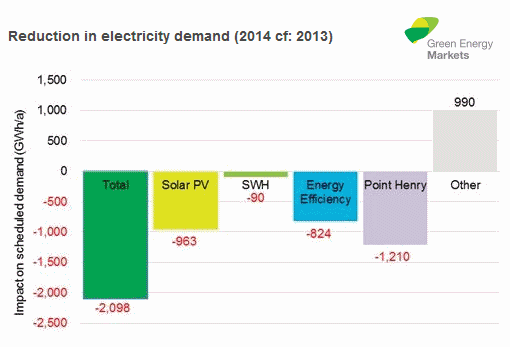
A new report shows that electricity demand in Australia’s National Electricity Market (NEM) has fallen again in 2014.
The decrease in electricity demand is a trend that began in 2008/2009 due to massive growths in solar energy as well as consumers (and appliances) becoming more energy efficient. This was also around the time that the networks started spending billions and gold plating the infrastructure. Figures from 2014 show a decrease of 1.1% or 2089GWhrs from that of the previous year.
In its annual review of the NEM, Green Energy Markets (GEM) says that solar power and energy efficiencies are responsible for 89% of the reduction or 1877GWhrs. Even though subsidies for renewable energy systems has been drastically reduced or stopped completely, Australia has still installed 700MW’s of rooftop solar in 2013 and in 2014.
Queensland was the only state to increase its electricity demand on the NEM by 0.9% while Victoria had the largest drop of 3.5%. Victoria’s significant drop also has a lot to do with the Point Henry aluminium smelter closing at the end of July 2014.

 According to the graph on the left, the closure of the Pt Henry smelter contributed 1 210GWhrs towards the total drop in electricity demand. Solar power contributed 963GWhrs, solar hot water 90GWhrs and energy efficiency schemes 824GWhrs.
According to the graph on the left, the closure of the Pt Henry smelter contributed 1 210GWhrs towards the total drop in electricity demand. Solar power contributed 963GWhrs, solar hot water 90GWhrs and energy efficiency schemes 824GWhrs.
While we may see decreases in electricity demand, the axing of the carbon tax has seen the NEM become very dirty. Hydro energy production dropped by 25% while brown coal (the dirtiest of the lot) increased by 1911GWhrs.
“With the increase in fossil fuel generation, the emission intensity of generation increased by 2.1 per cent with the overall level of greenhouse emissions increasing by 1 per cent,” says the report.
Click here to see the full report form Green Energy Markets.
Tags: Brown coal, carbon tax, electricity demand, energy-efficient, fossil fuel generation, gold plating, Green Energy Markets, greenhouse emissions, growths in solar energy, Hydro energy, National Electricity Market, NEM, renewable energy systems, rooftop solar, solar hot water, solar power
